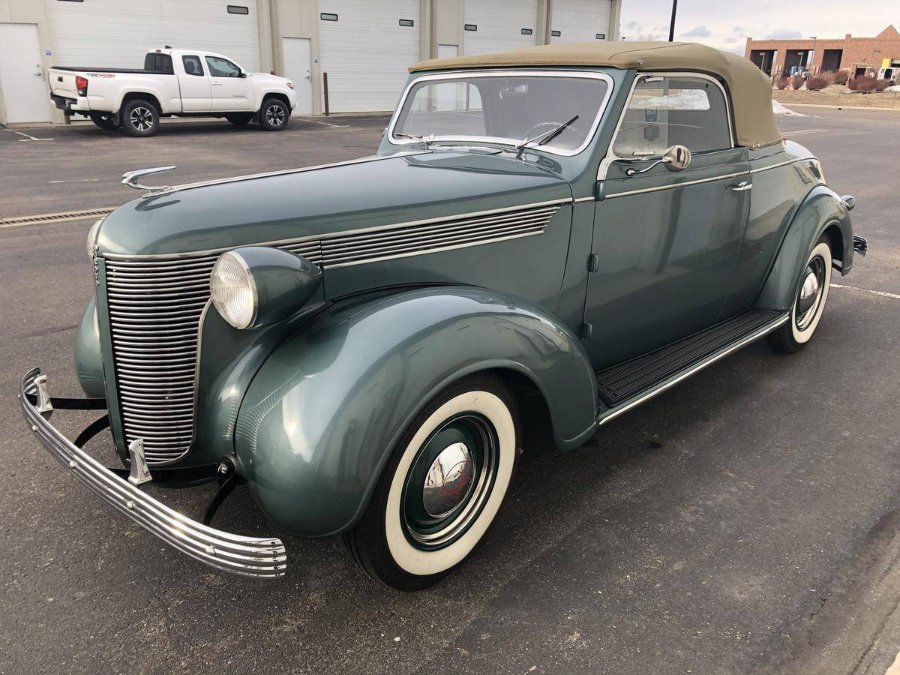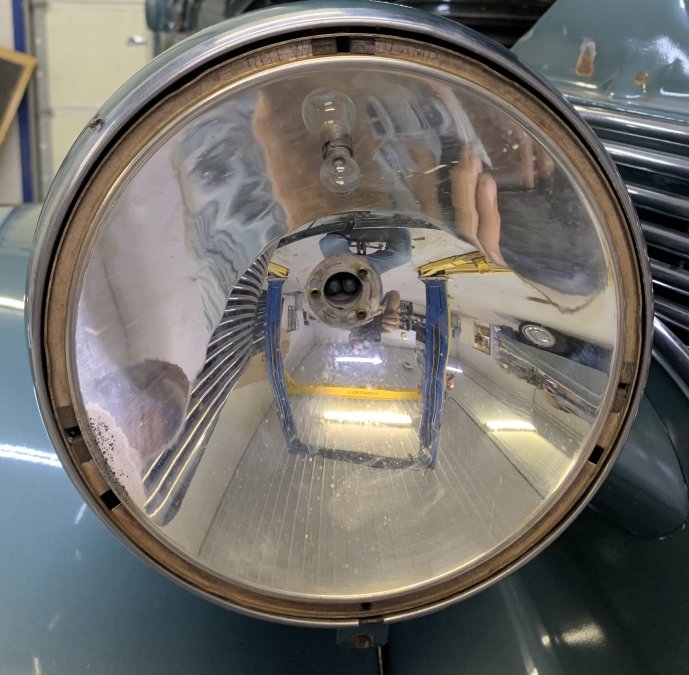
grubby65
Members-
Posts
20 -
Joined
-
Last visited
Content Type
Links Directory
Profiles
Articles
Forums
Downloads
Store
Gallery
Blogs
Events
Everything posted by grubby65
-
My "CRUISER" is a 1937 DeSoto convertible. It has an S-15 motor with a Nicson 2x1 intake, factory aluminum head, split exhaust manifold, and dual exhaust. The ticket on these cars is to get the RPM's down which means an overdrive transmission or drop the rear end ratio. I also have a 1933 DeSoto without overdrive transmission. When I went to replace the tires I went with a taller white wall. Coker offers two different diameters of 15" wide white wall tires, one is 24" and the other is 27". The taller tire helped a bunch and in my opinion fill the wheel wells better. My '37 has an overdrive and it cruises easily at 65 mph turning right at 220 rpm. For drivability, one of the biggest improvements I made was switching to modern gas shocks, really improved the handling. Braking can be an issue, but for those of us old enough one of things we were taught in Driver's Education class was to think ahead and try to anticipate other driver's moves, which can help keep you out of trouble.
-
NO problem, hope it helps.
-
Autolite Sisson Choke Training.pdf
-
I'm re-installing the head on my 1933 DeSoto and I'm trying to figure out what to torque the fasteners to. The '33's have studs not bolts, I have the instruction manual for the car but it has no torque specs. I found this on the internet, but I'm not sure if I agree with it. Course thread 7/16" X 14 TPI cap screws are 65 to 70 lbs as mentioned above.... Studs with 7/16" X 20 TPIi fine thread are 55lbs. Cylinder head clamping force ends up the same for both styles. Honestly I didn't realize thread pitch affects clamping pressure at the same torque, but the more I think about it, maybe it is correct. Any thoughts?
-
Thanks, that is exactly what I was looking for.
-
I'm trying to figure out which bulbs to install in my 1933 DeSoto. I have an original parts book plus the instruction booklet but none of them list any type of replacement bulb. The two I'm having issues with are: 1) Tail light/Brake light. The bulb which was in it has TS1175 on it. Try as I might, this bulb number does not exist. I have some 1158's coming, hopefully they will work. 2) Park light bulb (which goes in the head light housing). There were no bulbs in the sockets so I have no number to reference. I'm going to try and 87 and an 81. Does anyone know if there is chart or a book to reference these vintage bulbs?
-
Looking through Don Butler’s book it appears the cars with smooth bumpers had them mounted on the front while the fluted bumpers had them on the back.
-
Gem Green, original color.
-
I received an extra transmission when I purchased my 1933 DeSoto. It is a "free-wheeling" style. The casing number is 601344-4, but I can't seem to find the number in any of my DeSoto parts books. I was wondering if someone has an early 30's parts book who could identify it for me. I was thinking about rebuilding it for my DeSoto, but I don't know if it will fit or not.
-
- 1
-

-
I have a fully restored 1937, if you have questions. It does have an S-51 engine though. My email is terry.drury@chiefind.com
-
3) Adjust the timing by rotating the distributor, set dwell by adjusting the point gap. I would use a dwell meter for this purpose.
-
It is a factory aluminum head. The Chrysler part# is listed in the original post.
-
I just purchased an aluminum head (part #695795) to put on a S-15 DeSoto 25" motor. I'm new to the aluminum heads on a flat head, I was wondering if you guys might be able to answer some questions for me? 1) Would you use the copper head gasket or the more modern Fel-Pro sandwich style (7256-C) 2) Would you use head bolts or studs. I'm assuming with either I should use hardened washers. 3) I have read the aluminum heads used a different spark plug. If true do you know what number they are. I guess any other thoughts or concerns anyone has I am willing to listen. Thanks.
-
This is how I did my linkage on the '37 DeSoto, with and S-15 (251) motor, Nicson intake, and Carter carbs
-
I have a 1937 DeSoto with a 1951 S-15 motor. The previous owner kind of put it together with a mosh-mash of parts. I was going to replace the thermostat so I purchased one for a 1951 DeSoto. When I pulled the old thermostat out there was a piece of hose about 1/2” long on top of the thermostat, about twice as long as the rubber seal which came with the new thermostat. The part # on the thermostat housing is 640726. My guess it is for the 1937. Any thoughts would be appreciated, I’m assuming I need to get a thermostat for a 37 or the housing for a 51
-
I decided to just have the head trued. It took .009". Thanks for the thoughts, the article above really surprises me. Appears you can remove a lot of material and not affect the compression ratio very much.
-
I have the head from my S-15 at the machine shop. I was going to have .050" taken off to raise the compression ratio, but the guys at the shop thought it may have been cut before. I was wondering if there was a specification on the thickness of the head and where the measurements should be taken.
-
Thanks
-
I need to get into the headlight housing of my 1937 DeSoto and check the wiring at the bulb socket. Have power to the headlight but not at the socket. Have the lens removed, but struggling removing the reflector. Can someone go through the steps for removal? Nothing in the shop manual.
-
I'm looking at purchasing a 1938 Plymouth that is in my opinion very unique. It looks like most Hot Rods, but instead of the usual Small Block Chevy swap the builder elected to stay with the 230 cu. in. Flat Head six. It is about a six hour drive to go look at it, so I was wanting to get some opinions on what the members though the performance might be like. I'm familiar with this vintage of Chrysler products and expected cruising speed, but if I'm going to buy a car that looks like this I would like to be able to cruise at 75 mph, but I don't know if that is realistic. It has dual carburetors and it has a 5-speed manual transmission out of an S-10. It also has air conditioning. I know it is impossible to predict horsepower without knowing how the actual motor was built. 1938-plymouth-coupe-street-rod.jfif 1938-plymouth-coupe-street-rod (1).jfif




